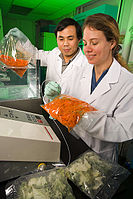
Photo from wikipedia
In food industry, a growing concern is the use of suitable packaging material (i.e., biodegradable coatings and films) with enhanced thermal, mechanical and barrier characteristics to prevent from contamination and… Click to show full abstract
In food industry, a growing concern is the use of suitable packaging material (i.e., biodegradable coatings and films) with enhanced thermal, mechanical and barrier characteristics to prevent from contamination and loss of foodstuff. Biobased polymer resources can be used for the development of biodegradable bioplastics. To achieve this goal, biopolymers should be economic, renewable and abundantly available. Bioplastic packaging materials based on renewable biomass could be used as sustainable alternative to petrochemically-originated plastic materials. This review summarizes the recent advancements in biopolymer-based coatings and films for active food packaging applications. Microbial polymers (PHA and PLA), wood-based polymers (cellulose, hemicellulose, starch & lignin), and protein-based polymers (gelatin, keratin, wheat gluten, soy protein and whey protein isolates) were among the materials most widely exploited for the development of smart packaging films. These biopolymers are able to synthesize coatings and films with good barrier properties against food borne pathogens and the transport of gases. Biobased reinforcements e.g., plant essential oils and natural additives to bioplastic films improve oxygen barrier, antibacterial and antifungal properties. To induce the desired functionality the simultaneous utilization of different synthetic and biobased polymers in the form of composites/blends is also an emerging area of research. Nanoscale reinforcements into bioplastic packaging have also been reported to improve packaging characteristics ultimately increasing food shelf life. The development of bioplastic/biocomposite and nanobiocomposites exhibits high potential to replace nonbiodegradable materials with characteristics comparable to fossil-based plastics, additionally, giving biodegradable and compostable characteristics. The idea of utilization of renewable biomass and the implications of biotechnology can firstly reduce the burden from fossil-resources, while secondly promoting biobased economy.
Journal Title: Food research international
Year Published: 2020
Link to full text (if available)
Share on Social Media: Sign Up to like & get
recommendations!